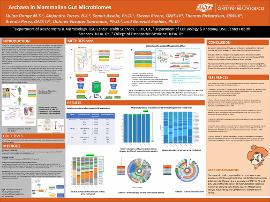| dc.contributor.author | Dange, Shilpa | |
| dc.contributor.author | Torres, Alejandro | |
| dc.contributor.author | Assefa, Senait | |
| dc.contributor.author | Rivera, Steven | |
| dc.contributor.author | Richardson, Thomas | |
| dc.contributor.author | Perez, Brenda | |
| dc.contributor.author | Vazquez-Sanroman, Dolores | |
| dc.contributor.author | Koehler, Gerwald | |
| dc.date.accessioned | 2023-09-12T16:45:21Z | |
| dc.date.available | 2023-09-12T16:45:21Z | |
| dc.date.issued | 2022-02-18 | |
| dc.identifier | ouhd_Dange_archaeainmammaliangut_2022 | |
| dc.identifier.citation | Dange, S., Torres, A., Assefa, S., Rivera, S., Richardson, T., Perez, B., Vazquez-Sanroman, D., & Koehler, G. (2022, February 18). Archaea in mammalian gut microbiomes. Poster presented at Research Days at Oklahoma State University Center for Health Sciences, Tulsa, Ok. | |
| dc.identifier.uri | https://hdl.handle.net/11244/339564 | |
| dc.description.abstract | Background: Archaea are the most enigmatic domain of the three domains of life. Archaea are unique in that they share some characteristics with bacteria and others with eukaryotes while they are also distinct from these two domains. Mostarchaea are extremophiles that are found in highly acidic, high salt, or high- temperature environments. However, recent microbiome research has revealed that these prokaryotes are also a part of the gut microbiota, albeit their functional roles in gut health or disease are unclear. Archaea could be keystone species in the gut that engage in important syntrophic relationships with other gut microbes. The recent proposal of archaeal strains as a new class of probiotics (archaebiotics) could be of interest for improving gut pathophysiology and overall human health. The main aim of this study is to mine extant microbiome data sets in our laboratory for the presence of archaeal sequences. | |
| dc.description.abstract | Method: Metagenomic data sets from mammalian microbiome studies (e.g., mouse, rat, prairie voles) based on 16S rRNA amplicon or whole-genome shotgun sequencing approaches are screened for archaeal sequences. Taxonomic profiling workflows in the Qiagen CLC Genomics Workbench and other bioinformatics software such as MetaPhlan are used to elucidate the relative abundances of these enigmatic microorganisms. | |
| dc.description.abstract | Results: Archaeal sequences have been found in DNA isolated from digesta and feces at relatively low abundances. Most sequence variants are derived from methanogens, a subgroup of archaea, while we also found indications for the presence of halophilic archaea. | |
| dc.description.abstract | Conclusion: Our experiments demonstrate that archaeal sequences, specifically from methanogens and halophiles, are found in our mammalian gut microbiome data sets. Future studies will include confirmation of archaeal presence using quantitative PCR (qPCR) and, if possible, in vitro culture. Predictions on the functional roles of archaea in the gut will also be conducted to help characterizethe impact of these microorganisms on gut health | |
| dc.format | application/pdf | |
| dc.language | en_US | |
| dc.publisher | Oklahoma State University Center for Health Sciences | |
| dc.rights | The author(s) retain the copyright or have the right to deposit the item giving the Oklahoma State University Library a limited, non-exclusive right to share this material in its institutional repository. Contact Digital Resources and Discovery Services at lib-dls@okstate.edu or 405-744-9161 for the permission policy on the use, reproduction or distribution of this material. | |
| dc.title | Archaea in mammalian gut microbiomes | |
| osu.filename | ouhd_Dange_archaeainmammaliangut_2022.pdf | |
| dc.type.genre | Presentation | |
| dc.type.material | Text | |
| dc.subject.keywords | archaea | |
| dc.subject.keywords | microbiota | |
| dc.subject.keywords | microbiome | |
| dc.subject.keywords | metagenome | |
| dc.subject.keywords | intestine | |
